If you are one of those companies that are looking for a way to secure the top spot in search engines like Google, you are in the right place to improve your SEO (SEO)
In a world where businesses are constantly obsessed with everything related to search engines, it would be inappropriate not to know all that they have to offer.
We assume you already know what a search engine results page (SERP) is. For the uninitiated, this is simply the endless list of results that comes up when you search on a search engine.
So yes, from the user's point of view, search engines offer solutions to their queries by producing a list of relevant websites. From the point of view of businesses, search engines connect them with relevant target audiences.
In return, search engines offer several features on SERPs in addition to organic results. These are called SERP features. We're talking about the knowledge panel, the rich snippets, the People Also Ask section — all that and more.
So, if you're a business that decided to enter the SEO world to dominate SERPs, it's always a good idea to understand all of the features they offer. But of course, there are other reasons why you should target SERP features.
Let's talk more about this, okay?
Are you wondering how SERP characteristics affect my website?
Search engines go to great lengths to ensure that only the most relevant results are shown for any user query. Don't get me wrong: a higher organic ranking in the SERPs can be very useful. But the additional features of Google SERPs can immediately offer users a lot of relevant information that isn't necessarily visible in organic results.
SERP characteristics can also offer a lot of information about what keywords you should be targeting and what type of content will give you the best visibility. Plus, you can take advantage of this information to develop your content and SEO strategies.
If you're still wondering if SERP features are worth it, what about the fact that only 2.65% of result pages are displayed without any sort of SERP features? Yes, it helps to gain Google SERP features.
Because SERP features use different types of content, businesses can also be inspired by the specific types of content they should include in their content strategy. In fact, it's about going beyond the good old “blue links.”
Businesses have every interest in targeting Google's SERP features to benefit from maximum exposure and establish their credibility. That said, let's start by exploring the different types of SERP features and everything you need to know about them.
Now that you know what SERP features are and the potential benefits they can offer your business, let's take a look at the full list of SERP features you can use. We're going to dig deep into each Google SERP feature and understand the best practices you can follow to optimize that feature.
That said, let's start with this detailed guide to Google SERP features.
If you regularly use Google for your searches, you have certainly come across a featured snippet. It is a large box that displays a specific section of the most relevant web page on the SERP, based on your search query. The purpose of a featured snippet is to offer an instant response to a user's request, without the user having to click on any of the links on the website.
Featured snippets usually appear at the top of the SERPs, but in some rare cases, they can also take another position instead of an organic search result. In addition, unlike several other SERP features, featured snippets are mobile-friendly.
Featured Snippets can contain multiple types of items such as tables, images, videos, listicles, and even widgets, depending on the search query.
The search intent for featured snippets will almost always be informative, with the exception of a few navigation queries. They can easily answer questions that contain “what,” “why,” and “how,” other than simpler action-based queries.
Featured snippets get more than 35% of the total number of clicks on the SERPs. It's an important part to let go, isn't it?
Let's take an example to better understand. When we searched for “what are the keywords in The SEO“- a common informational request, this is what the SERP looked like:
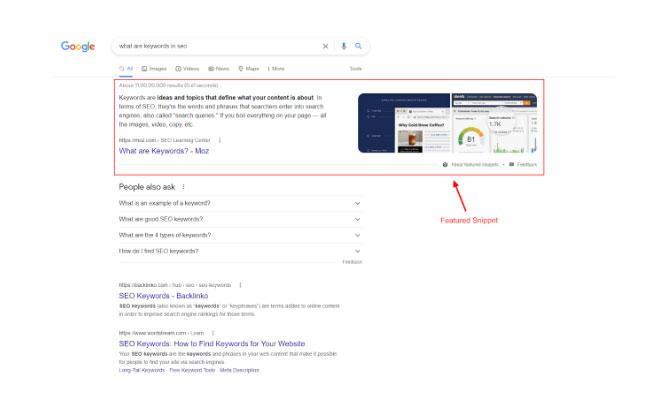
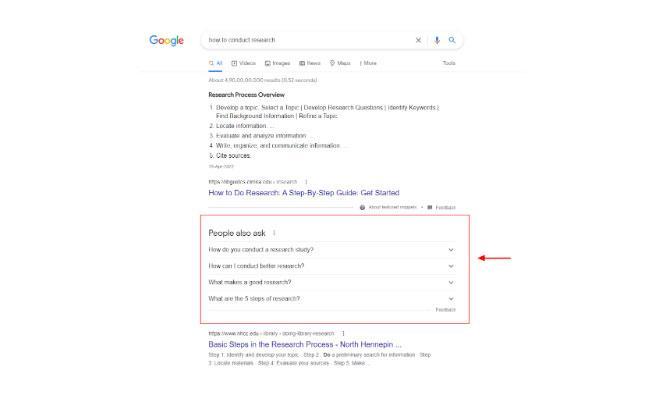
With these best practices, you can optimize your content to easily reach featured snippets. After all, they're now considered one of the top 10 organic SERP results and enjoy a much higher click-through rate.
The fact that Google can show the likely questions you have based on your search queries is just wonderful. How does Google do it?
You've certainly seen the People Also Ask (PAA) boxes - a list of frequently asked questions related to your search queries. Well integrated into organic search results, the “People Also Ask” section helps you find answers to questions you have about the subject of your search.
It's Google's way of showing its intuitive abilities by answering questions before you even ask them. By clicking on it, each question expands to reveal an answer formatted as a featured snippet.
Like featured snippets, the “People Also Ask” section is displayed on mobile devices as well as desktop computers. However, it is well known that its frequency is higher on mobile devices than on desktop computers.
Each time AAP is triggered, it appears in 75% of cases in the top three positions, which significantly improves your visibility on the SERPs.
In general, long-tail keywords are the most appropriate if you want to be included in the “People Also Ask” section. For example, keywords like “how to prepare a buyer persona” may be more effective than a keyword like “prepare a buyer persona,” if you want to target the PAA section.
In terms of search intent, you can cover different types of search intent just as effectively. But using People Also Ask is much less common for transactional keywords.
Let's try it, okay?

It's always a good idea to incorporate these best practices when creating content to increase the chances of being included in the AAP section.
Links. Links.
What would search engines and businesses be without them? No matter what we talk about in SEO, it seems like it always comes back to links, right? Well, that's the way it is for a good reason. Search engines identify and navigate web pages through links, and so do your potential customers.
While organic SERP results are full of them, sitelinks are another SERP feature that you need to consider the impact of. Why? Well, if you do it right, your domain can totally dominate the SERPs.
Sitelink links generally come in two formats:
The main purpose of sitelinks is to expand the traditional SERP result and offer multiple link addresses that users can quickly choose from, based on what they are looking for. This is a very useful feature for large websites that have high traffic. So it's not surprising that you often see sitelinks when looking for an e-commerce website.
SERP functionality can be triggered using keywords that include a brand term, brand name, or domain. The search intent of users is therefore quite clear: they already know the brand's offer and are looking for a specific transaction. Now let's try to better understand this using an example:

See how much space your website can take up in the SERPs if sitelinks are triggered for your site. Now that you know what they are, let's look at some best practices that can help you optimize this SERP feature.
If you can get sitelinks to appear in the SERPs for your website, you can significantly improve your visibility and CTR.
97% of people are discovering a local business online more than anywhere else.
This shows how powerful local SEO can be for your business to be discovered in the SERPs.
This Google SERP feature has a number of benefits, especially if you're a brick-and-mortar business. The local pack is triggered and works on desktop computers as well as mobile devices.
The local map pack is triggered when the user's request indicates a local search intent. Google then strives to extract the most relevant results based on the request and the user's geographical location.
Now let's take an example. Let's say you live in Adelaide and are looking for a good seafood restaurant nearby for dinner. You could look for something like “seafood restaurants in Adelaide,” right? This query tells Google that you are actively looking for a seafood restaurant in Adelaide. To be honest, Google is smart enough to understand that even if you've done a search like “seafood restaurants near me.”
However, let's look at what comes up when you do a search on this topic:

The advantage of being a local business and being included in the Google local map pack is that you have every chance of being in position 0 if you do it right. For local business websites, it's hard to compete with local directories in SERP rankings due to their high traffic and domain authority.
However, the SERP function of local packs can easily give you this visibility - provided you optimize your Google Business (GBP) profile and integrate your profile with Google Maps. The advantage? Over 86% of Internet users use Google Maps to find the location of a business.
Therefore, if you are a local business that wants to be discovered by local customers on Google, complete your listing and Encourage your customers to post reviews on your Google business profile.
With these best practices, and by ensuring that your business profile is filled in correctly, you can get better visibility and even appear on the first page of Google SERPs at no cost. Remember that local businesses can target a large number of SERP features based on their capabilities and authority.
If you haven't heard of rich snippets or if you don't know what they are, let us tell you that you've probably come across a lot of them when you Google.
You may not have paid particular attention to it, but you certainly said to yourself “what a useful feature.” Indeed, rich snippets are nothing more than subtle extensions of the organic results displayed in the SERPs.
These results are clearly different from the others because they are more detailed. As Google continues to experiment with new ways to make search results more engaging and useful, traditional organic results now include images, videos, and in some cases, snippets.
Because people are inclined to click on results that provide more information, rich snippets can significantly increase your click rate. As people click more on your page than on others, Google will notice that your page is more preferred, which will have a positive impact on your ranking.
Rich snippets are triggered by various types of search intentions, the most common of which are transactional and informational queries. You can use structured data to have your search results appear as rich snippets in the SERPs. Now let's look at an example of a “rich snippet.”
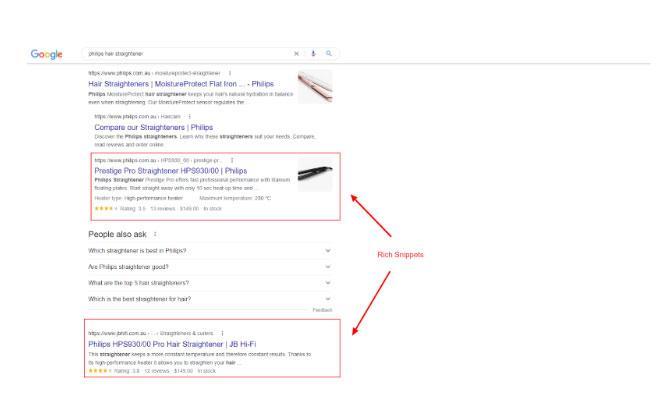
SEO performance is important, especially if you're a small business, which is why it's important to enable and appear in SERP features like rich snippets.
We have at one time or another searched for celebrities on Google or found trendy Hollywood gossip. The best stories come up when you do this type of research. Like the featured snippets and the “People Also Ask” section, the “Top Stories” section is an important SERP feature that you've certainly seen or interacted with.
The “Top Stories” section is displayed in the SERPs as a carousel of news articles or videos related to your search queries. If your search term matches an article that arouses a lot of interest, Google will show it in the “Top Stories” section. This SERP feature is another example of a feature that appears both on desktop and on mobile searches.
Pretty explicit, no?
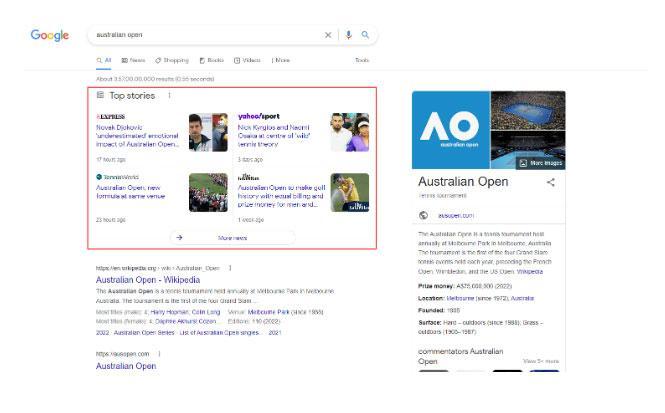
While the position of top-tier articles varies from search to search, they generally rank higher in the SERPs, which again is a great thing for increasing your brand's visibility.
News articles apply to publications that create news content and articles about current trends. The search intent here, as you might guess, will be informative, with search queries pointing to topics that have been covered in the news recently.
If you belong to an editorial team that wants to be included in this coveted section of the SERPs, here are some tips to follow.
It goes without saying that if your article is in the “Top Stories” section, you are likely to get more exposure than many of your competing posts. It's also likely to be shared more than others if you ensure high content quality.
A picture is worth a thousand words, they say. At least sometimes.
In accordance with this principle, Google displays a series of images in your organic results for specific search queries. These are queries where Google believes that images are more valuable than text content. So these search queries end up triggering the Image Pack feature — another organic SERP feature.
The presence of an image in the image pack offers a multitude of advantages for you. Of course, this increases the chances of your image being reused by a user and allows you to get a backlink. Also, if a sufficient number of users find your image useful and click on your link, the additional visibility and traffic it can bring is undeniable.
Like most organic features in Google SERPs, the Image Pack is triggered on both desktop and mobile devices.
Image Pack is most commonly triggered by queries that indicate informational or commercial search intent. So think of direct keywords that could best describe your niche. But remember that Image Pack ranking rules go beyond the organic ranking algorithm.
For example, if you are a distributor of branded cameras and peripherals, you can benefit from displaying high-quality product images on your website. So, for a Canon 200D image, be sure to define it as such in the image file name, alt text, and URLs. The result?
For starters, you can find your featured image for this search query. Just above all of the top-performing organic results that are shown in the SERPs.

So, if you're a small business looking to improve its SEO and organic visibility in the SERPs, this SERP feature for images can help.
We've all been there: we're feverishly looking on the web for instructions on “how” to do something. Since these queries represent a significant portion of search engine traffic, most search engines go the extra mile to facilitate the answers to these queries.
Whether your business sells products or services, chances are you have a handy guide on your website. A how-to guide can be as detailed as you want and usually offers detailed instructions for completing a specific task. Ideally, these documents can and should include a combination of various elements such as text, video, and images.
If you think your how-to guide is quite detailed and informative and should definitely be on the first page, Google's SERP features offer you the perfect opportunity. You can add HowTo structured data so that each step in your how-to guide is read in order. It will also help you get a rich result for your practical guide in the SERPs.
This feature is available on mobile and desktop devices.
As you might have already guessed, the search intent you need to target is informational. You're looking for queries that come in the form of questions, so it can be helpful to include long-tail keywords as questions. In this case, you're looking for keywords like “how to tie a tie” or “how to clean artificial grass.”
Here is an example of what that looks like.

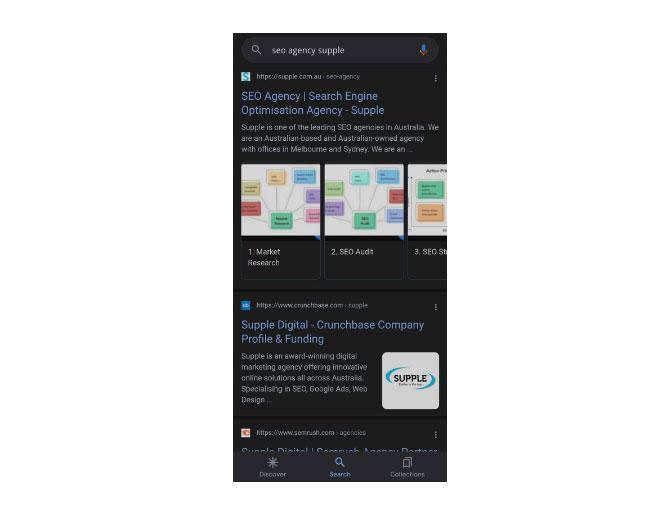
As you can see, there's a lot to be gained by triggering the “How To” SERP feature, as it gives you better organic visibility.
Frequently asked questions (FAQ) are not a foreign concept to any company that has designed a detailed website. FAQs are the most common questions your users are likely to ask about your product or service. So, as a customer-oriented company, you try to answer them in advance, using keywords and research about your target audience.
But did you know that when you add FAQs to your website and optimize them properly, they take a different form than a SERP element?
The SERP FAQ feature is just as effective on desktop computers as it is on mobile devices.
The search intent that triggers FAQs is generally informative. Relevant search queries can include a wide range of long-tail keywords and brand terms. In some cases, these requests may also be transactional or navigation-related.
For example, you might have a page dedicated to refunds and cancellations FAQ on your e-commerce site. However, many customers have questions about these policies before they even decide to make purchases on your site. In this case, they should be able to access the web page easily.
Notice how, even if you haven't specifically searched for FAQs, the FAQs in the relevant search results appear in the form of an extendable accordion. This result can be achieved if you add the structured data from the FAQ to your schema markup.
You'll also be able to identify and resolve FAQ errors or red flags in Google Search Console.
The biggest benefit of triggering FAQs is leveraging the customer's attention to help them make decisions that will move them forward in the conversion funnel.
Have you already looked for jobs on specific portals, only to come back to good old Google? If you answered yes, you should know that the job search function was created by Google with users like you in mind.
The job search function is nothing but a long list of job postings grouped together from various job portals like Indeed, Glassdoor, and other company websites that have posted job ads. All you need to do is search for your relevant job profile like a simple Google search and find a list of openings that you might be interested in.
Not posting active job openings on your website or posting them in the SERPs is a missed opportunity. You could use them to gain greater visibility in SERPs and drive more traffic to your website.
Search intent is very important when you want to trigger this function. Keywords with intent modifiers such as “jobs” or “job opportunities” trigger the job search function. Thus, in this case, search queries will most often have an informational, navigational, or transactional intent.
For example, if you're a digital agency based in Melbourne offering an SEO specialist position, you should target keywords like “SEO specialist job” in your website post. You can also use a more specific keyword phrase, such as “SEO specialist jobs in Melbourne.” What is the result? Let's see.
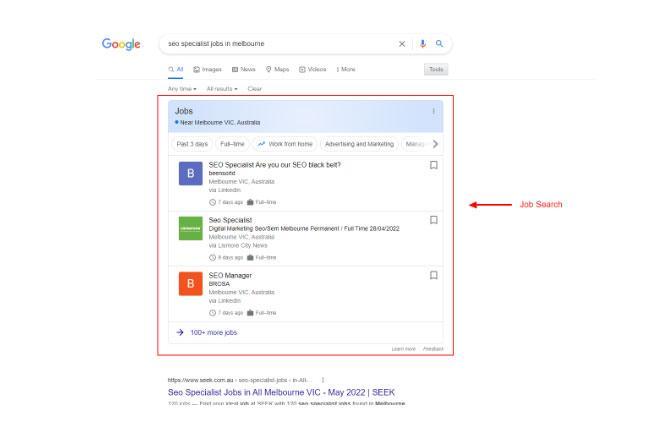
The job search SERP function is displayed effectively on desktops and mobile devices. It wouldn't be a bad idea to get extra visibility for your business, right?
Podcasts are all the rage today, aren't they? Over 80% Podcast listeners finish all or at least most of the podcast episodes they start.
Google identified the growing popularity of this content format and increased the visibility of podcasts in the SERPs. Now, whenever you search for a podcast or any information related to it, Google shows three podcast episodes in a dedicated section. And the best?
These episodes are directly readable from the SERPs. You can play, pause, rewind, and fast-forward these episodes from podcasts.google.com. For other advanced features, it is possible to download the podcast platform on Google Play and continue listening.
Some even go so far as to say that this may be the start of the SEO podcast.
So if you have a podcast to promote, you should look to make the most of this feature. And yes, this feature is available on desktop computers as well as mobile devices.
It goes without saying that this Google SERP feature will be triggered if your user's search intent can be satisfied by displaying podcasts as results. More specifically, you are addressing users who are conducting informational or commercial research. Using keywords like “content marketing podcast” or a specific podcast name like “marketing podcast that everyone hates” triggers the SERP feature.
Take a look at the results that came out when we tried it out.

If your team has the expertise and resources to create podcasts, this is a great opportunity to increase your brand's visibility and increase popularity organically. Plus, as more people listen to podcasts, you can be assured of consistent traffic over time.
The global lockdown due to COVID-19 has highlighted one thing: everyone needs to learn to cook for themselves. Fittingly, the years 2020 and 2021 saw a sharp increase in the number of amateur cooks looking for new basic recipes. It would not be wrong to say that many have survived because millions of recipes were available to them in a few clicks.
In a few clicks. How did that become possible? Thanks to Google, of course.
Google understood the constant demand for revenue around the world and decided to make it a SERP feature several years ago. The Recipe feature is displayed as a rich snippet that describes the duration, main ingredients, and details of the recipe poster, all supported by images. This is one of the examples of SERP features that are available for mobile and desktop devices.
The “Recipe” function is triggered whenever users search for something related to food. Search queries that trigger this function can take several forms. These keywords could be “how to make banana bread,” “banana bread at home,” “banana bread recipe,” or even just “banana bread.” The “recipes” section aims to answer all keywords that convey an informative search intent.

This means that if you're a chef or chef who wants to gain a bit more traction on SERPs, you can benefit from integrating a wide range of recipe-related keywords into the content. Additionally, you should also consider optimizing it for SEO.
You should add details such as cooking time, ingredients, and nutritional information to the structured data to increase the chances of being included in the recipe section. How your recipe shows up in the SERPs and how visible it is depends largely on how you tag your content. Regularly monitor the evolution of the SERP functionality to assess your results.
Today, 3D is no longer just a thing in the entertainment world. Given its numerous applications in the business world, it is not surprising that Google introduced it into the SERPs. This new SERP feature allows users to view images in 3D and in augmented reality.
The “View in 3D” SERP feature allows you to view specific images in 3D and interact with them using augmented reality. Note that this is a Google mobile SERP feature. This feature is only supported on mobile devices running Android 7 and up, or iOS 11 and up.
While Google has worked on the widespread application of this SERP feature, it is currently restricted to searches on animals, cultural heritage sites, human anatomical systems, and biological terms, among a few other categories. Google shows the “View in 3D” function only for queries whose search intent is identified as informative.
Thus, the 3D view is likely to be triggered if your search queries are simple like “lion”, “Eiffel Tower” or “tiger”. Let's take a quick look at how this feature works.
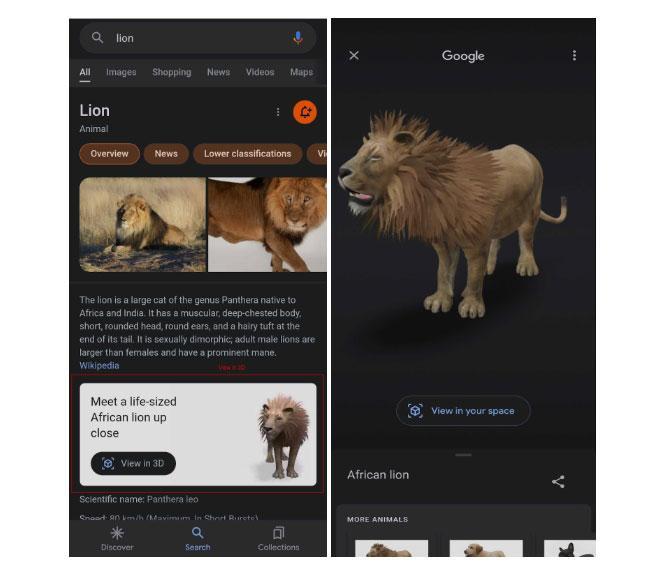
When you click the “View in 3D” button, Google displays a virtual reality version of your search that you can interact with. This AR version is displayed with the corresponding sounds. So, in the case of a lion, you can hear its roar when you interact with it.
Google has also enabled this SERP feature for e-commerce sites, so that customers can see and inspect the products before buying them.
One of the best things that works so well for Google as a search engine is its obsession with making sure that every user who uses it gets the right solution. The “People Are Looking Too” section fits perfectly into this philosophy.
Even though all of Google's SERP features aim to optimize the user experience, this one is the most cutting-edge. The “People Also Search For” (PASF) feature is used whenever a user clicks on a search result and immediately returns to the SERP page. This indicates that the user did not find what they were looking for. Google therefore displays this section with search queries that are relevant to the initial query, in order to help users with their searches.
Let's quickly see how that works before we talk more about it, okay?
Let's say you're looking for professional pest control services for your residential property in Sydney. So you're doing what everyone else would do. You opened Google, and typed in “Sydney Pest Control Services.” Here's what came out.

So you clicked on the first organic result because you were attracted to it. But once you landed on the website, you realized that it didn't quite meet your expectations. So you went directly back to the SERP to look for other solutions. But now you have a “People are also looking” field that offers you other keywords to find the right solution.

While this feature is triggered after the initial desktop search, the “People are also looking” section is displayed as soon as the initial search is performed on your mobile devices. While this Google SERP feature doesn't have a lot of implications for businesses, it does give you a list of keywords that you should incorporate to rank in relevant search queries.
In 2015, at the peak of Twitter's popularity, Google introduced a new SERP feature: a box displaying tweets directly in the SERP. The Tweets section will show the most recent and trending tweets related to the search query.
The Tweet SERP function is displayed on mobile devices as well as on desktop devices. So it's useful to cover current topics on your Twitter feed, after all. The Tweets section can appear anywhere in the SERPs, but its overall position is just above the organic results.
Since the section displays tweets from verified and unverified profiles, even small businesses with a limited number of followers have the opportunity to improve their visibility in the SERPs through this section. Users can click on one of the tweets to go to the Twitter profile and view other tweets.
Now let's see what this section looks like.
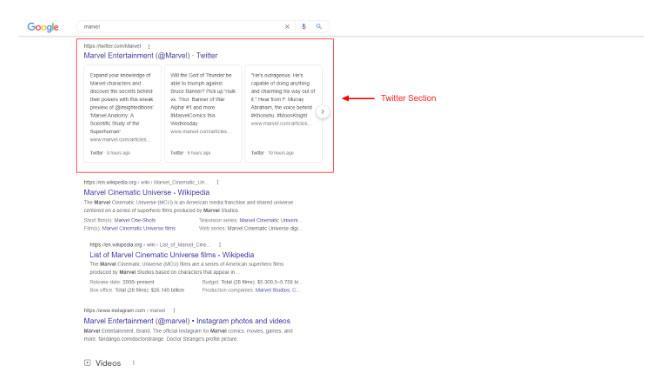
For businesses that struggle to appear on the first page of the SERPs, let alone rank at the top, being on the Twitter section can give you the exposure your brand needs.
It's not uncommon for users to prefer video content over blogging and text content when looking for detailed solutions.
For marketers, videos can be useful in a variety of sales and marketing tasks. To begin with, more than 86% Marketers say that videos help them generate leads for their brand.
With this in mind, Google introduced the video carousel as a prominent feature in SERPs. The video carousel is displayed in the organic results when a user searches. These videos are retrieved from platforms such as YouTube, Vimeo, and websites that contain embedded videos.
The video carousel is displayed just as effectively on mobile devices as it is on desktop computers. It's important to note that not all keywords trigger the video function. You'll also need to include video schema markup data. This video section can appear at any position in the organic results.
Here's what the results looked like when we did the search.
Videos tend to appear more often for keywords that indicate informational or commercial search intent. For example, keywords like “what is a black hole” or “what is a metaverse” are more likely to trigger the video function than other types of keywords.

Videos are definitely more engaging and tend to perform better than other content formats. Not to mention that being included in the video section is an easy way to increase your visibility and secure your position in the SERPs.
Have you ever searched for specific quantitative data on Google and seen a detailed graph corresponding to your query appear on the SERP? You don't need to click on any of the results anymore, do you?
Well, it's a knowledge card.
Knowledge maps are generally part of the knowledge graph and can present semantic data and data-rich content transparently in SERPs. The knowledge map can retrieve data from human-edited sources, just like other sources in the Google index.
Unfortunately, knowledge maps are largely beyond the reach of regular commercial websites because the data comes from websites edited by humans and approved by Google, or from those with which they have entered into data agreements. Unless you have high domain authority and a steady flow of traffic to your website.
It's good to keep track of the keywords that trigger this feature so you can exploit them in your content. Regardless of the subject, the search intent that triggers this feature is essentially informative.
It shouldn't surprise you at this point that SERP features offer SEO benefits. And yes, knowledge maps are triggered on desktop searches as well as on mobile searches.
Now let's see what a knowledge map looks like. For example, we searched for “age of the Australian prime minister.” Here's what the SERP looked like for this search query.
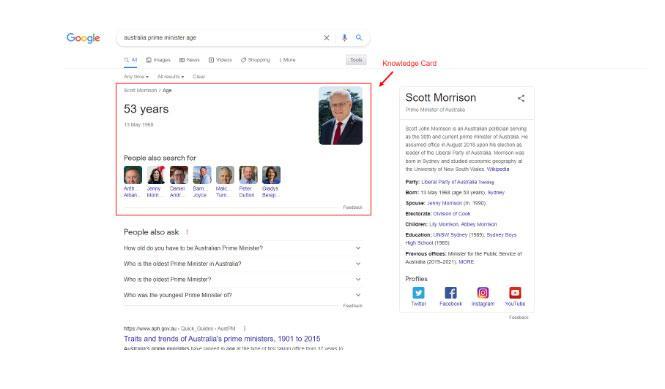
Now let's talk about the knowledge panel - a definitive extension of the knowledge map, also known as the Knowledge Graph.
The knowledge panel is one of the most common SERP features that we've all come across. Like knowledge sheets, they extract information from a variety of credible sources that have partnered with Google or have the greatest authority in the field.
The Knowledge Panel appears on the right side of your organic results when triggered. A real demonstration of the fact that SERP results and functionalities go hand in hand. It typically appears in desktop searches as well as mobile searches. Only the positioning differs, as it appears at the top of the page for mobile searches.
The search intent that triggers this SERP feature is informational. Simple queries that indicate that the user wants to know more about the subject of the request trigger the knowledge panel. Let's better understand this with the help of an example.
In this example, we searched for “Albert Einstein.” The results of this search look like this:

As with knowledge sheets, most websites will not be able to contribute to the knowledge panel. However, you can take note of the keywords that trigger the feature and use them in your content. This can help you improve the visibility of your brand in the SERPs.
85% of product searches online take place on Amazon or Google. Let yourself be convinced.
We know that you are one of those people who go to Google and look for product reviews and comparisons before making a buying decision. We do that too. And that's exactly why shopping results work so well for people like us.
Purchase results are triggered on desktops as well as mobile devices as soon as you search for a product.
The search intent that triggers this Google SERP feature is transactional and commercial. So, if users conduct searches that indicate they want to buy a product, or if they are looking for alternatives, Google will trigger the purchase results. Right off the bat, keywords like “buy iPhone 13" or “iPhone 13 price” are essential triggers for this feature.
For example, we tried to Google “buy iPhone 13". Here's what came out.
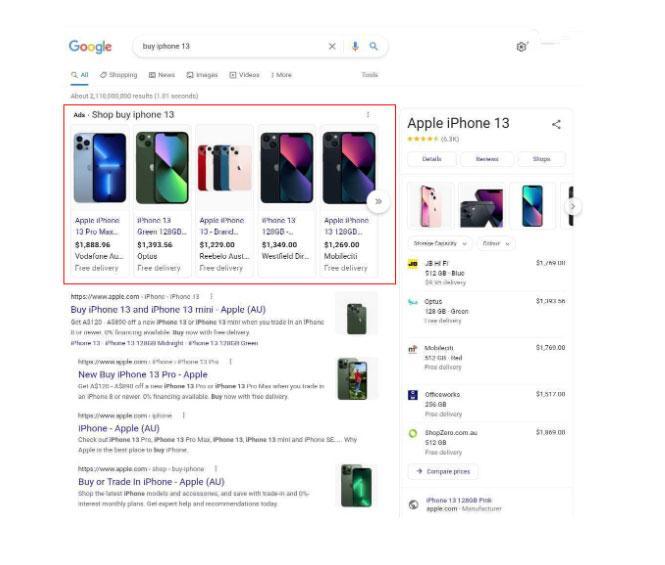
It bodes well for businesses to check which keywords trigger the “Purchase Results” function and incorporate them into their content. However, keep in mind that this is a paid placement. But no matter how many SERP features you're ranked for, this one should be on your list if you're a e-commerce business.
The main purpose of this feature is clear: users get a wide range of options for their search queries, compiled from a variety of websites. They don't need to look for other queries or, at least, be guided in the right direction.
We may be used to seeing Google ads appear as often as organic search results, but it's important to tell them apart. You can, of course, identify Google ads by the “Ad” tag that accompanies them.
But one of the other categories you need to be aware of is upper ads and lower ads.
There's not much difference between the two ads other than how they look. In most cases, the appearance is not much different either.
Search intent doesn't play a role, as Google bases ads on user preferences and location.
In this regard, Google Support states that “ads are ranked primarily based on their relevance and usefulness in relation to what the person searched for, your bid, and a few other factors.”
Here's an example of a prominent ad we came across when we searched for “buy iPhone 13" for the previous example.

For the same search query, the lowest ads appeared:
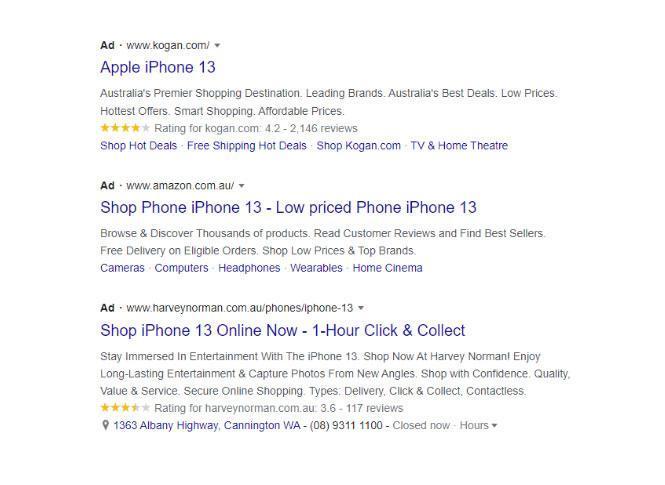
Google ads are not the ultimate organic solution, but for small and medium-sized businesses, they can often be the cornerstone of their marketing efforts. Optimizing upper and lower ads is critical to converting more customers and getting a better return on investment — and of course, better visibility on SERPs.
In addition to organic results, Google is constantly working on additional features that enrich the user experience. Each time a user searches on the search engine, several features are triggered based on the search intent behind these queries. These are Google SERP features. They generally appear as part of the organic results or in addition to them on the SERP.
Among the features of the Google SERP, there are several that are useful and that you should be aware of. Some of the most common SERP features include Featured Snippets, the Knowledge Panel, People Also Ask, and top and bottom ads. Each of these features helps users find solutions to their queries more easily.
There is no one-size-fits-all answer to the question “how do you get SERP capabilities.” Each SERP feature is triggered by specific types of search intentions and search queries. For example, if your search query indicates a transactional search intent, and includes intent modifiers such as “buy” or “buy,” purchase results are likely to be triggered.
To target SERP functionalities, it is important to first tidy up your website and its content. Optimize your website in accordance with prescribed SEO standards. Seek help from an expert SEO agency if needed.
Additionally, you can also improve your content and include keywords that target search intent that may trigger a specific SERP feature. By following these steps and building a domain authority consistently, you will be able to appear in Google's current SERP features.
Current SERP features generally occupy an important position on SERPs — either above, between, or alongside organic results. Regardless of the position, SERP features are prominently displayed on the page, giving high visibility to those on it.
Businesses that are struggling to find their place on the front page of SERPs can target SERP features to achieve this. They can offer greater visibility, better recognition, and even greater credibility to the brands that appear on them.
Isn't the aim always to increase visibility and authority in SERPs, for all growing businesses and organizations? Rightly so. Businesses spend thousands of dollars to get the kind of online visibility and engagement that can bring a steady flow of traffic and visibility to the first page of SERPs.
SERP features are the way to accomplish all of this and more, in an organic way that will also have an indirect impact on the performance of your website. Hopefully you now have a good understanding of all things SERP features. Start your journey to target these features, optimizing your website and content.